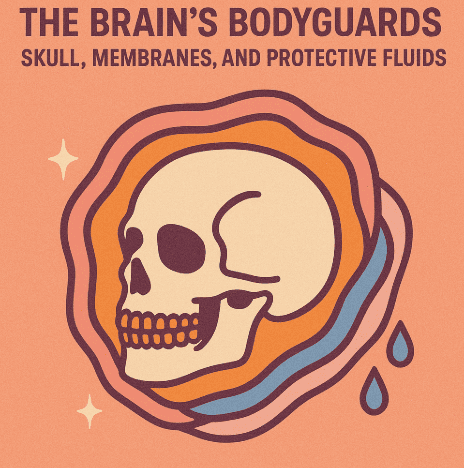
Recap of Lesson 4
In Lesson 4, we discovered how neurons form networks that give rise to thought. We learned:
-
The connectome is the map of all brain connections.
-
Neurons form circuits for specialized tasks like vision, memory, or movement.
-
Learning happens through Hebbian learning (“neurons that fire together, wire together”).
-
Networks can be efficient because of small-world structures — local clusters with long-distance shortcuts.
Now, before we go deeper into how the brain learns and remembers, we must first answer an important question: How is the brain kept safe?
Section 1: Why the Brain Needs Protection
The brain is like a supercomputer made of jelly. It’s soft, squishy, and cannot repair itself easily if damaged. Unlike your skin, it doesn’t grow back well. Unlike your bones, it’s fragile.
But your brain is so important that evolution gave it multiple layers of protection. Think of it like a castle 🏰:
-
The walls of the castle = the skull
-
The inner guards and armor = membranes (meninges)
-
The moat of water around it = cerebrospinal fluid
Together, these protect the king inside — your brain.
Section 2: The Skull – The Hard Helmet
The skull is the bony structure of your head. It’s like a helmet built into your body.
-
The skull has 22 bones that are fused together (in adults) to make a protective case.
-
It’s hard and rigid, protecting against blows and injuries.
-
It also gives shape to your face and holds your sense organs (eyes, ears, nose, mouth).
But the skull is not enough on its own. It’s like a helmet without padding — good against big impacts, but the brain still needs cushioning inside.
Section 2: The Skull – The Hard Helmet
The skull is the bony structure of your head. It’s like a helmet built into your body.
-
The skull has 22 bones that are fused together (in adults) to make a protective case.
-
It’s hard and rigid, protecting against blows and injuries.
-
It also gives shape to your face and holds your sense organs (eyes, ears, nose, mouth).
But the skull is not enough on its own. It’s like a helmet without padding — good against big impacts, but the brain still needs cushioning inside.
Section 3: The Meninges – Triple Armor Layers
Underneath the skull, the brain has three protective membranes called the meninges.
-
Dura mater (“tough mother”) – The tough outer layer, right under the skull. It’s thick and leathery, like armor plating.
-
Arachnoid mater (“spider mother”) – The middle layer, web-like and delicate, like a soft cushion.
-
Pia mater (“tender mother”) – The innermost layer, thin and clingy, sticking tightly to the brain’s surface.
The meninges protect the brain, carry blood vessels, and hold cerebrospinal fluid.
-
Dura mater → “tough mother”
-
Dura = tough, hard.
-
Mater = mother.
-
Early physicians saw it as the “protective mother” layer hugging the skull, shielding the brain like armor.
-
-
Arachnoid mater → “spider mother”
-
Arachnoid comes from the Greek aráchnē = spider.
-
When peeled away in dissections, it looked like a spiderweb stretched over the brain because of all the fine connective tissue strands.
-
Again, mater = mother, continuing the “protective mother” theme.
-
-
Pia mater → “tender mother”
-
Pia = gentle, tender.
-
This layer hugs the brain closely, following every fold and groove, almost like a mother’s gentle embrace.
-
So the “mother” part comes from the idea of these membranes being nurturing, protective coverings, while the adjectives (tough, spider, tender) describe their appearance or texture.
💡 Fun fact: Infections of the meninges are called meningitis, which can be very dangerous.
Section 4: Cerebrospinal Fluid – The Brain’s Moat
The cerebrospinal fluid (CSF) is a clear liquid that surrounds the brain and spinal cord. Think of it as the moat around the castle.
-
Cushioning: It acts like a shock absorber, protecting the brain from sudden jolts (like jumping or bumping your head).
-
Nourishment: It delivers nutrients to brain cells.
-
Waste removal: It clears away waste products from the brain.
-
Buoyancy: It makes the brain “float,” reducing its effective weight from 1.4 kg to about 50 grams! This prevents the brain from squishing itself under its own weight.
CSF circulates through spaces called ventricles (hollow areas inside the brain) and around the spinal cord.
Section 5: The Blood-Brain Barrier – The Security Checkpoint
The brain has another hidden protector: the blood-brain barrier (BBB).
This is a special filter between the blood and the brain.
-
It allows in good things like oxygen and glucose (sugar for energy).
-
It blocks out harmful things like bacteria, toxins, and many drugs.
Think of it like a VIP club bouncer 👮. Only the right guests can enter.
But this also makes treating brain diseases hard, because many medicines cannot cross the BBB.
Section 6: When Protection Fails
Despite these protections, the brain is still vulnerable. Examples:
-
Concussion → When the brain bounces against the skull after a hit.
-
Stroke → When blood supply is blocked or a vessel bursts.
-
Meningitis → Infection of the meninges.
-
Hydrocephalus → Too much CSF builds up, increasing pressure.
This shows why helmets 🪖 are so important in sports and cycling — the skull is strong, but it can’t handle everything.
Section 7: The Big Picture
The brain is fragile, but it has:
-
A hard skull (outer wall)
-
Three meninges (armor layers)
-
Cerebrospinal fluid (moat)
-
A blood-brain barrier (security system)
Together, these bodyguards let the brain do its amazing work safely.